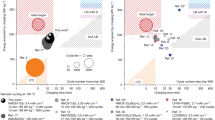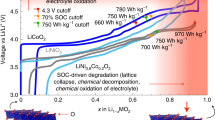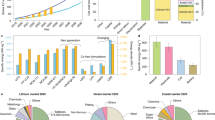Abstract
The pursuit of energy density has driven electric vehicle (EV) batteries from using lithium iron phosphate (LFP) cathodes in early days to ternary layered oxides increasingly rich in nickel; however, it is impossible to forgo the LFP battery due to its unsurpassed safety, as well as its low cost and cobalt-free nature. Here we demonstrate a thermally modulated LFP battery to offer an adequate cruise range per charge that is extendable by 10 min recharge in all climates, essentially guaranteeing EVs that are free of range anxiety. Such a thermally modulated LFP battery designed to operate at a working temperature around 60 °C in any ambient condition promises to be a well-rounded powertrain for mass-market EVs. Furthermore, we reveal that the limited working time at the high temperature presents an opportunity to use graphite of low surface areas, thereby prospectively prolonging the EV lifespan to greater than two million miles.
This is a preview of subscription content, access via your institution
Access options
Access Nature and 54 other Nature Portfolio journals
Get Nature+, our best-value online-access subscription
$29.99 / 30 days
cancel any time
Subscribe to this journal
Receive 12 digital issues and online access to articles
$119.00 per year
only $9.92 per issue
Buy this article
- Purchase on Springer Link
- Instant access to full article PDF
Prices may be subject to local taxes which are calculated during checkout






Similar content being viewed by others
Data availability
All relevant data are included in the paper and its Supplementary Information. Source data are provided with this paper.
Code availability
The case files for the cell performance and degradation simulations on Autolion-1D v7.0 are publicly available at https://github.com/ECECPSU/TMLFP
References
Fast Facts: US Transportation Sector Greenhouse Gas Emissions (1990–2018) (US EPA, 2019); https://nepis.epa.gov/Exe/ZyPDF.cgi?Dockey=P100ZK4P.pdf
Needell, Z. A., McNerney, J., Chang, M. T. & Trancik, J. E. Potential for widespread electrification of personal vehicle travel in the United States. Nat. Energy 1, 16112 (2016).
Electric Vehicle Outlook 2020 (BloombergNEF, 2020); https://about.bnef.com/electric-vehicle-outlook/
Lienert, P. & Chan, C. Global automakers investing at least $300 billion on batteries and EVs. Reuters (2019); https://graphics.reuters.com/AUTOS-INVESTMENT-ELECTRIC/010081ZB3HD/index.html
Whittingham, M. S. Lithium batteries and cathode materials. Chem. Rev. 104, 4271–4302 (2004).
Nitta, N., Wu, F., Lee, J. T. & Yushin, G. Li-ion battery materials: present and future. Mate. Today 18, 252–264 (2015).
Schmuch, R., Wagner, R., Hörpel, G., Placke, T. & Winter, M. Performance and cost of materials for lithium-based rechargeable automotive batteries. Nat. Energy 3, 267–278 (2018).
Li, M., Lu, J., Chen, Z. & Amine, K. 30 Years of lithium-ion batteries. Adv. Mater. 30, 1800561 (2018).
Ding, Y., Cano, Z. P., Yu, A., Lu, J. & Chen, Z. Automotive Li-ion batteries: current status and future perspectives. Electrochem. Energy Rev. 2, 1–28 (2019).
Andre, D. et al. Future generations of cathode materials: an automotive industry perspective. J. Mater. Chem. A 3, 6709–6732 (2015).
LFP market share drops in 2019 but expect a comeback with cell-to-pack. Adamas Intelligence (4 March 2020); https://www.adamasintel.com/lfp-market-2019-cell-to-pack-comeback/
Sun, Y.-K. et al. High-energy cathode material for long-life and safe lithium batteries. Nat. Mater. 8, 320–324 (2009).
Olivetti, E. A., Ceder, G., Gaustad, G. G. & Fu, X. Lithium-ion battery supply chain considerations: analysis of potential bottlenecks in critical metals. Joule 1, 229–243 (2017).
Manthiram, A., Knight, J. C., Myung, S.-T., Oh, S.-M. & Sun, Y.-K. Nickel-rich and lithium-rich layered oxide cathodes: progress and perspectives. Adv. Energy Mater. 6, 1501010 (2016).
Manthiram, A., Song, B. & Li, W. A perspective on nickel-rich layered oxide cathodes for lithium-ion batteries. Energy Storage Mater. 6, 125–139 (2017).
Xiong, R., Ma, S., Li, H., Sun, F. & Li, J. Toward a safer battery management system: a critical review on diagnosis and prognosis of battery short circuit. iScience 23, 101010 (2020).
Feng, X., Ren, D., He, X. & Ouyang, M. Mitigating thermal runaway of lithium-ion batteries. Joule 4, 743–770 (2020).
Noh, H.-J., Youn, S., Yoon, C. S. & Sun, Y.-K. Comparison of the structural and electrochemical properties of layered Li[NixCoyMnz]O2 (x = 1/3, 0.5, 0.6, 0.7, 0.8 and 0.85) cathode material for lithium-ion batteries. J. Power Sources 233, 121–130 (2013).
Yamada, A., Chung, S. C. & Hinokuma, K. Optimized LiFePO4 for lithium battery cathodes. J. Electrochem. Soc. 148, A224 (2001).
Zaghib, K. et al. Enhanced thermal safety and high power performance of carbon-coated LiFePO4 olivine cathode for Li-ion batteries. J. Power Sources 219, 36–44 (2012).
Lamb, J., Torres-Castro, L., Stanley, J., Grosso, C. & Gray, L. S. Evaluation of Multi-cell Failure Propagation SAND-2020-2802 (Sandia National Laboratories, 2020); https://doi.org/10.2172/1605985
Wang, Z., Zhu, K., Hu, J. & Wang, J. Study on the fire risk associated with a failure of large-scale commercial LiFePO4/graphite and LiNixCoyMn1-x-yO2/graphite batteries. Energy Sci. Eng. 7, 411–419 (2019).
New Energy Vehicles Safety Monitoring Results Report (National Big Data Alliance of New Energy Vehicles, 2019).
Morris, J. Tesla’s shift to cobalt-free batteries is its most important move yet. Forbes (11 July 2020); https://www.forbes.com/sites/jamesmorris/2020/07/11/teslas-shift-to-cobalt-free-batteries-is-its-most-important-move-yet/
Mullaney, T. Tesla and the science behind the next-generation, lower-cost, ‘million-mile’ electric-car battery. CNBC TECH TRENDS (30 June 2020); https://www.cnbc.com/2020/06/30/tesla-and-the-science-of-low-cost-next-gen-ev-million-mile-battery.html
Takahashi, M., Ohtsuka, H., Akuto, K. & Sakurai, Y. Confirmation of long-term cyclability and high thermal stability of LiFePO4 in prismatic lithium-ion cells. J. Electrochem. Soc. 152, A899 (2005).
Wang, C., He, L., Sun, H., Lu, P. & Zhu, Y. Battery pack, vehicle and energy storage device. China Patent CN110165118B (2019).
He, K., Jiang, W., Wang, X. & Wen, A. Single battery, power battery pack and vehicle. China Patent CN110364675A (2019).
Jiang, L., Yang, K., Zhu, Y. & Zhu, J. Electric connector and battery comprising the same. United States Patent US20170346065A1 (2017).
Kwon, M., Choi, J., Kwon, K., Do, E. & Lee, Y. Complex electrode assembly including plurality of electrode assemblies and electrochemical device comprising the complex electrode assembly. United States Patent US20200020922A1 (2020).
Gallagher, K. G. et al. Optimizing areal capacities through understanding the limitations of lithium-ion electrodes. J. Electrochem. Soc. 163, A138–A149 (2015).
Battery Requirements for Future Automotive Applications (EUCAR, 2019); https://eucar.be/wp-content/uploads/2019/08/20190710-EG-BEV-FCEV-Battery-requirements-FINAL.pdf
Dynamometer Drive Schedules. United States Environmental Protection Agency https://www.epa.gov/vehicle-and-fuel-emissions-testing/dynamometer-drive-schedules
Wang, C. Y. et al. Lithium-ion battery structure that self-heats at low temperatures. Nature 529, 515–518 (2016).
Yang, X. G. et al. Asymmetric temperature modulation for extreme fast charging of lithium-ion batteries. Joule 3, 3002–3019 (2019).
Yang, X. G., Zhang, G., Ge, S. & Wang, C. Y. Fast charging of lithium-ion batteries at all temperatures. Proc. Natl Acad. Sci. USA 115, 7266–7271 (2018).
Yang, X. et al. All-climate battery technology for electric vehicles: inching closer to the mainstream adoption of automated driving. IEEE Electrific. Mag. 7, 12–21 (2019).
Zhang, G. et al. Rapid self-heating and internal temperature sensing of lithium-ion batteries at low temperatures. Electrochim. Acta 218, 149–155 (2016).
Nelson, P. A., Ahmed, S., Gallagher, K. G. & Dees, D. W. Modeling the Performance and Cost of Lithium-Ion Batteries for Electric-Drive Vehicles 3rd edn ANL/CSE-19/2 (Argonne National Laboratory, 2020).
Lutsey, N. & Nicholas, M. Update on Electric Vehicle Costs in the United States Through 2030 1–12 (International Council on Clean Transportation, 2019).
Americans Spend an Average of 17,600 Minutes Driving Each Year (American Automobile Association, 2016); https://newsroom.aaa.com/2016/09/americans-spend-average-17600-minutes-driving-year/
Naumann, M., Schimpe, M., Keil, P., Hesse, H. C. & Jossen, A. Analysis and modeling of calendar aging of a commercial LiFePO4/graphite cell. J. Energy Storage 17, 153–169 (2018).
Smith, A. J., Burns, J. C., Zhao, X., Xiong, D. & Dahn, J. R. A high precision coulometry study of the SEI growth in Li/graphite cells. J. Electrochem. Soc. 158, A447 (2011).
Harlow, J. E. et al. A wide range of testing results on an excellent lithium-ion cell chemistry to be used as benchmarks for new battery technologies. J. Electrochem. Soc. 166, A3031–A3044 (2019).
Cheng, J. H., Harlow, J. E., Johnson, M. B., Gauthier, R. & Dahn, J. R. Effect of duty cycle on the lifetime of single crystal LiNi0.5Mn0.3Co0.2O2/graphite lithium-ion cells. J. Electrochem. Soc. 167, 130529 (2020).
Schimpe, M. et al. Comprehensive modeling of temperature-dependent degradation mechanisms in lithium iron phosphate batteries. J. Electrochem. Soc. 165, A181–A193 (2018).
Wang, C. Y. et al. A fast rechargeable lithium-ion battery at subfreezing temperatures. J. Electrochem. Soc. 163, A1944–A1950 (2016).
Yang, X. G., Leng, Y., Zhang, G., Ge, S. & Wang, C. Y. Modeling of lithium plating induced aging of lithium-ion batteries: transition from linear to nonlinear aging. J. Power Sources 360, 28–40 (2017).
Mastali, M., Farkhondeh, M., Farhad, S., Fraser, R. A. & Fowler, M. Electrochemical modeling of commercial LiFePO4 and graphite electrodes: kinetic and transport properties and their temperature dependence. J. Electrochem. Soc. 163, A2803–A2816 (2016).
Mastali, M. et al. Electrochemical-thermal modeling and experimental validation of commercial graphite/LiFePO4 pouch lithium-ion batteries. Int. J. Therm. Sci. 129, 218–230 (2018).
Fiori, C., Ahn, K. & Rakha, H. A. Power-based electric vehicle energy consumption model: model development and validation. Appl. Energy 168, 257–268 (2016).
Acknowledgements
Financial support from the US Department of Energy’s Office of Energy Efficiency and Renewable Energy (EERE) under award no. DE-EE0008355 and the William E. Diefenderfer Endowment is gratefully acknowledged. We are also grateful to Gamma Technologies for providing licences to GT-Autolion software, with which we performed the ECT modelling.
Author information
Authors and Affiliations
Contributions
X.G.Y and C.Y.W. conceived the idea and wrote the manuscript. X.G.Y. designed and performed the modelling studies. All authors contributed to analyses of the results.
Corresponding author
Ethics declarations
Competing interests
The authors declare no competing interests.
Additional information
Peer review information Nature Energy thanks Partha Mukherjee, Kandler Smith and Karim Zaghib for their contribution to the peer review of this work.
Publisher’s note Springer Nature remains neutral with regard to jurisdictional claims in published maps and institutional affiliations.
Supplementary information
Supplementary Information
Supplementary Tables 1 and 2, Figs. 1–14 and Note 1.
Source data
Source Data Fig. 6
Source data of Fig. 6, including comments on the sources of these data points and associated references.
Rights and permissions
About this article
Cite this article
Yang, XG., Liu, T. & Wang, CY. Thermally modulated lithium iron phosphate batteries for mass-market electric vehicles. Nat Energy 6, 176–185 (2021). https://doi.org/10.1038/s41560-020-00757-7
Received:
Accepted:
Published:
Issue Date:
DOI: https://doi.org/10.1038/s41560-020-00757-7
This article is cited by
-
Sustainable plug-in electric vehicle integration into power systems
Nature Reviews Electrical Engineering (2024)
-
Subtractive transformation of cathode materials in spent Li-ion batteries to a low-cobalt 5 V-class cathode material
Nature Communications (2024)
-
Electrochemical benefits of conductive polymers as a cathode material in LFP battery technology
Journal of Solid State Electrochemistry (2024)
-
Comparison of three typical lithium-ion batteries for pure electric vehicles from the perspective of life cycle assessment
Clean Technologies and Environmental Policy (2024)
-
Realistic fault detection of li-ion battery via dynamical deep learning
Nature Communications (2023)



